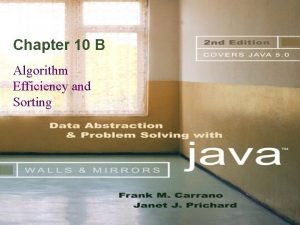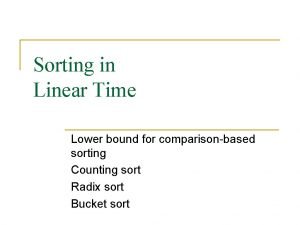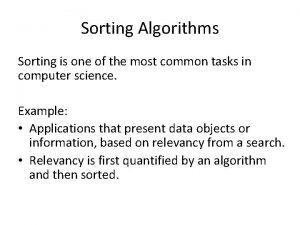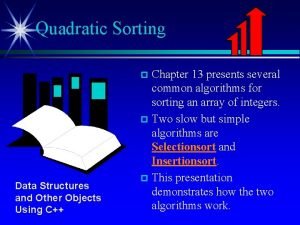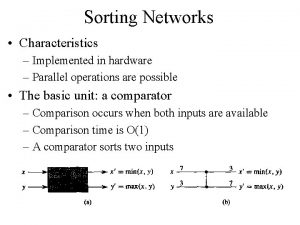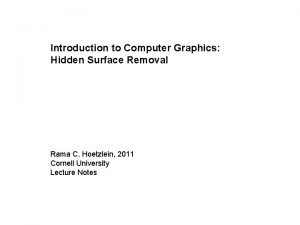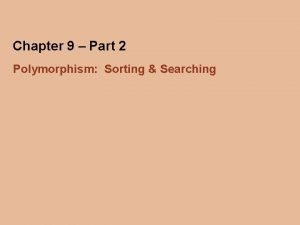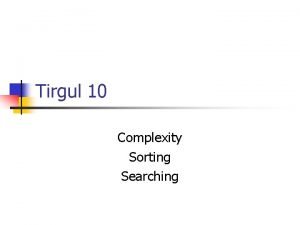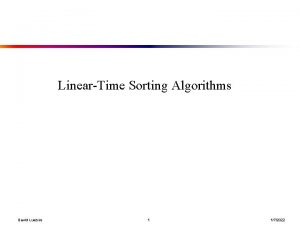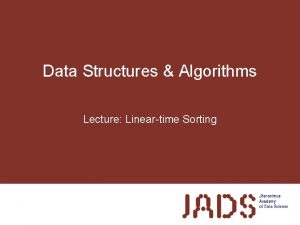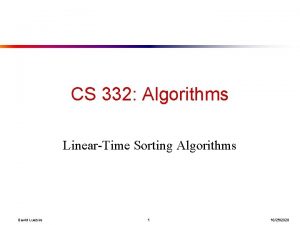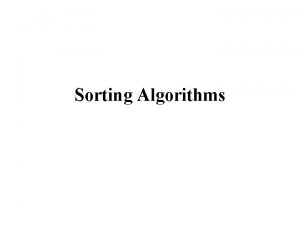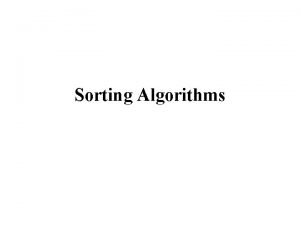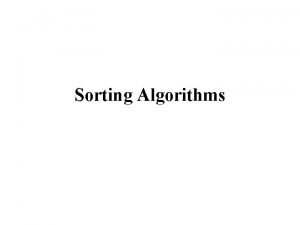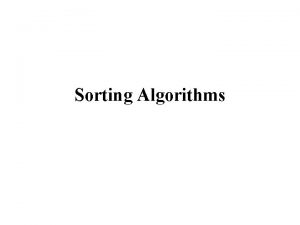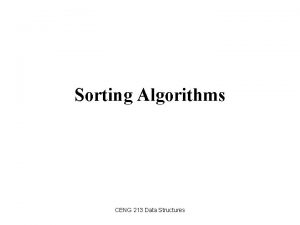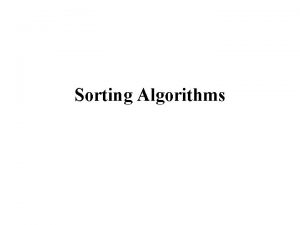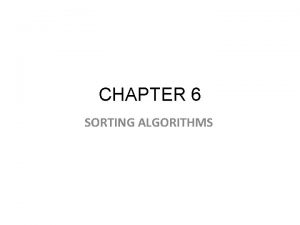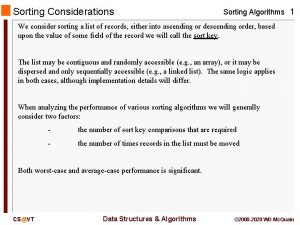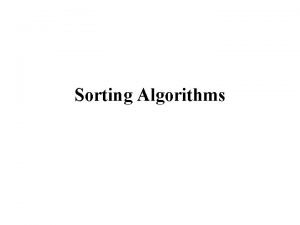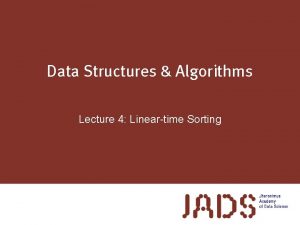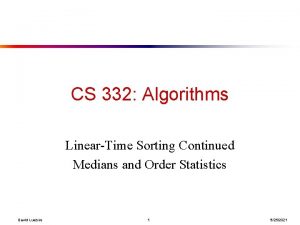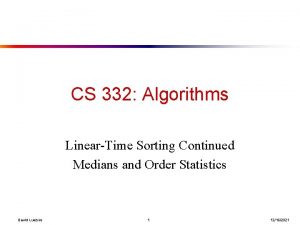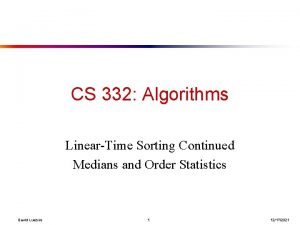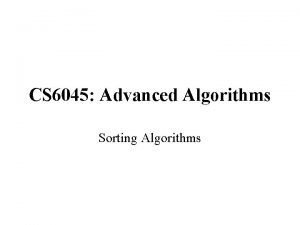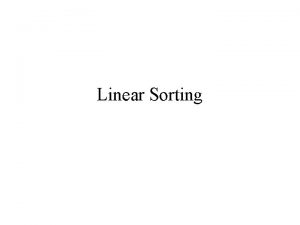CSC 41513 Intro to Algorithms LinearTime Sorting Algorithms
























- Slides: 24

CSC 41/513: Intro to Algorithms Linear-Time Sorting Algorithms

Sorting So Far l Insertion sort: n n n Easy to code Fast on small inputs (less than ~100 elements) Fast on nearly-sorted inputs O(n 2) worst case O(n 2) average (equally-likely inputs) case O(n 2) reverse-sorted case

Sorting So Far l Merge sort: n Divide-and-conquer: u Split array in half u Recursively sort subarrays u Linear-time merge step n n O(n lg n) worst case Doesn’t sort in place

Sorting So Far l Heap sort: n Uses the very useful heap data structure u Complete binary tree u Heap property: parent key > children’s keys n n n O(n lg n) worst case Sorts in place Fair amount of shuffling memory around

Sorting So Far l Quick sort: n Divide-and-conquer: u Partition array into two subarrays, recursively sort u All of first subarray < all of second subarray u No merge step needed! n n n O(n lg n) average case Fast in practice O(n 2) worst case u Naïve implementation: worst case on sorted input u Address this with randomized quicksort

How Fast Can We Sort? We will provide a lower bound, then beat it l First, an observation: all of the sorting algorithms so far are comparison sorts l n n The only operation used to gain ordering information about a sequence is the pairwise comparison of two elements Theorem: all comparison sorts are (n lg n) u. A comparison sort must do O(n) comparisons (why? ) u What about the gap between O(n) and O(n lg n)

Decision Trees l Decision trees provide an abstraction of comparison sorts n A decision tree represents the comparisons made by a comparison sort. Every thing else ignored What do the leaves represent? l How many leaves must there be? l

Decision Trees l Decision trees can model comparison sorts. For a given algorithm: n n n One tree for each n Tree paths are all possible execution traces What’s the longest path in a decision tree for insertion sort? For merge sort? What is the asymptotic height of any decision tree for sorting n elements? l Answer: (n lg n) (now let’s prove it…) l

Lower Bound For Comparison Sorting Thm: Any decision tree that sorts n elements has height (n lg n) l What’s the minimum # of leaves? l What’s the maximum # of leaves of a binary tree of height h? l Clearly the minimum # of leaves is less than or equal to the maximum # of leaves l

Lower Bound For Comparison Sorting So we have… n! 2 h l Taking logarithms: lg (n!) h l Stirling’s approximation tells us: l l Thus:

Lower Bound For Comparison Sorting l So we have l Thus the minimum height of a decision tree is (n lg n)

Lower Bound For Comparison Sorts Thus the time to comparison sort n elements is (n lg n) l Corollary: Heapsort and Mergesort are asymptotically optimal comparison sorts l But the name of this lecture is “Sorting in linear time”! l n How can we do better than (n lg n)?

Sorting In Linear Time l Counting sort n n No comparisons between elements! But…depends on assumption about the numbers being sorted u We n assume numbers are in the range 1. . k The algorithm: A[1. . n], where A[j] {1, 2, 3, …, k} u Output: B[1. . n], sorted (notice: not sorting in place) u Also: Array C[1. . k] for auxiliary storage u Input:

Counting Sort 1 2 3 4 5 6 7 8 9 10 Counting. Sort(A, B, k) for i=1 to k C[i]= 0; for j=1 to n C[A[j]] += 1; for i=2 to k C[i] = C[i] + C[i-1]; for j=n downto 1 B[C[A[j]]] = A[j]; C[A[j]] -= 1; Work through example: A={4 1 3 4 3}, k = 4

Counting Sort 1 2 3 4 5 6 7 8 9 10 Counting. Sort(A, B, k) for i=1 to k Takes time O(k) C[i]= 0; for j=1 to n C[A[j]] += 1; for i=2 to k C[i] = C[i] + C[i-1]; Takes time O(n) for j=n downto 1 B[C[A[j]]] = A[j]; C[A[j]] -= 1; What will be the running time?

Counting Sort l Total time: O(n + k) n n l Usually, k = O(n) Thus counting sort runs in O(n) time But sorting is (n lg n)! n n No contradiction--this is not a comparison sort (in fact, there are no comparisons at all!) Notice that this algorithm is stable

Counting Sort Why don’t we always use counting sort? l Because it depends on range k of elements l Could we use counting sort to sort 32 bit integers? Why or why not? l Answer: no, k too large (232 = 4, 294, 967, 296) l

Radix Sort l l l Intuitively, you might sort on the most significant digit, then the second msd, etc. Problem: lots of intermediate piles of cards (read: scratch arrays) to keep track of Key idea: sort the least significant digit first Radix. Sort(A, d) for i=1 to d Stable. Sort(A) on digit i n n Example: Fig 8. 3 Another example: 62, 39, 41, 12, 46, 30, 66

Radix Sort Can we prove it will work? l Sketch of an inductive argument (induction on the number of passes): l n n Assume lower-order digits {j: j<i}are sorted Show that sorting next digit i leaves array correctly sorted u If two digits at position i are different, ordering numbers by that digit is correct (lower-order digits irrelevant) u If they are the same, numbers are already sorted on the lower-order digits. Since we use a stable sort, the numbers stay in the right order

Radix Sort What sort will we use to sort on digits? l Counting sort is obvious choice: l n n l Each pass over n numbers with d digits takes time O(n+k), so total time O(dn+dk) n l Sort n numbers on digits that range from 0. . k-1 (i. e. , base k) Time: O(n + k) When d is constant and k=O(n), takes O(n) time How many bits in a computer word?

Radix Sort l Problem: sort 1 million 64 -bit numbers n n l Compares well with typical O(n lg n) comparison sort n l Treat as four-digit radix 216 numbers Can sort in just four passes with radix sort! Requires approx lg n = 20 operations per number being sorted So why would we ever use anything but radix sort?

Radix Sort l In general, radix sort based on counting sort is n n l Fast Asymptotically fast (i. e. , O(n)) Simple to code A good choice To think about: Can radix sort be used on floating-point numbers?

Bucket Sort l Bucket sort n n Assumption: input is n reals from [0, 1) Basic idea: u Create n linked lists (buckets) to divide interval [0, 1) into subintervals of size 1/n u Add each input element to appropriate bucket and sort buckets with insertion sort n Uniform input distribution O(1) bucket size u Therefore n the expected total time is O(n) These ideas will return when we study hash tables

The End
 What is internal and external sorting
What is internal and external sorting 10 sorting algorithms
10 sorting algorithms Introduction to sorting algorithms
Introduction to sorting algorithms Efficiency of sorting algorithms
Efficiency of sorting algorithms Bsort
Bsort Insertion sort decision tree 4 elements
Insertion sort decision tree 4 elements C sorting algorithms
C sorting algorithms N
N Clhelse
Clhelse N log n vs n
N log n vs n Most common sorting algorithms
Most common sorting algorithms Quadratic sorting algorithms
Quadratic sorting algorithms Searching and sorting arrays in c++
Searching and sorting arrays in c++ Sorting network
Sorting network Bubble sort vs selection sort
Bubble sort vs selection sort Willy
Willy Hidden surface removal adalah
Hidden surface removal adalah Tujuan dari sorting
Tujuan dari sorting Harry poter houses
Harry poter houses Searching and sorting in java
Searching and sorting in java Sorting and grading difference
Sorting and grading difference Grain size sorting formula
Grain size sorting formula Is topological sort unique
Is topological sort unique A sorting technique is called stable if: *
A sorting technique is called stable if: * Physical and chemical properties sorting activity
Physical and chemical properties sorting activity



